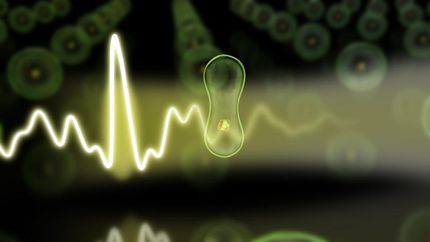Attosecond Electron Catapult
A team of physicists and chemists from the University of Rostock, the laboratory of attosecond physics at the Ludwig-Maximilians-Universität, the Max Planck Institute of quantum optics, and Freie Universität Berlin has studied the interaction of light with tiny glass particles.
The relationship between strong laser pulses and glass nanoparticles is a special one – one that could influence medical methods, as scientists from Rostock, Munich, and Berlin have discovered. The interplay between light and matter was studied by a team of physicists and chemists from the Laboratory of Attosecond Physics (LAP) at the Max Planck Institute of Quantum Optics (MPQ) and the Ludwig-Maximilians-Universität Munich (LMU), from the Institute of Physics of the University of Rostock, and from Freie Universität Berlin. The researchers studied the interaction between strong laser pulses and glass nanoparticles, which consist of multiple millions of atoms. Depending on how many atoms were contained in the nanoparticles, these objects reacted differently over attosecond timescales. Depending on their size, so called near-fields (electromagnetic fields close to the particle surface) were induced by the laser pulses, resulting in a controlled directional emission of electrons. These findings could eventually extend cancer therapy and imaging methods in medicine.
Strong laser pulses have an extremely pronounced effect on nanoparticles. As soon as the atoms “feel” the electromagnetic wave of the light, their electrons start to oscillate. This produces near-fields at the surface of the particles. These near-fields have dimensions in the nanometer range, and oscillate in a characteristic fashion depending on the wavelength of the incident light.
Led by Prof. Matthias Kling, the LAP-physicists studied silica nanospheres with diameters of 50 to 550 nanometers, which were chemically synthesized in the research group around Eckart Rühl at Freie Universität Berlin. The scientists let strong, approximately four-femtosecond-long laser pulses hit the group of atoms. As soon as the electromagnetic waves of the light field hit the nanospheres, near-fields formed at the surface and began to pulsate. The larger the light-irradiated spheres were compared to the laser wavelength (720 nanometers), the stronger the effect of the near-fields as an electron catapult.
The researchers observed this effect by using particle detectors to monitor the flight paths of electrons emitted from the near-fields of the nanospheres within the passage of the laser pulse. “The energy and direction of emitted electrons is strongly linked to the spatial and temporal structure of the near-fields. The emission of electrons is like a ping-pong game on the surface of the nanospheres that can be controlled with a precision of attoseconds,” explains Prof. Thomas Fennel from the University of Rostock. He conducted simulations with his team, shedding light on the microscopic processes and their evolution in time. “First, the electrons leave the spheres, but they are then pulled back to their surface. After bouncing off the surface, they obtain a strong, final momentum kick from the near-field, which frees them from the nanoparticles,” Prof. Matthias Kling added.
Since the directional emission of particles can be controlled with this technique using laser light, the researchers argue that a long-term perspective could be medical applications. “With directional electron motion, strongly directed X-rays for imaging applications could be produced,” describes Prof. Eckart Rühl. With sufficiently intense laser pulses, it may also be possible to release ions, which are charged atoms, from the nanocomposite, resulting in strongly directed ion radiation for cancer therapy. Furthermore, the technique might open up new perspectives for material processing beyond the diffraction limit – for instance in order to remove nanometer-sized areas from a surface.
Original publication
F. Süßmann, L. Seiffert, S. Zherebtsov, V. Mondes, J. Stierle, M. Arbeiter, J. Plenge, P. Rupp, C. Peltz, A. Kessel, S.A. Trushin, B. Ahn, D. Kim, C. Graf., E. Rühl, M.F. Kling, T. Fennel, "Field propagation-induced directionality of carrier-envelope phase-controlled photoemission from nanospheres", Nature Comm. 2015
Original publication
F. Süßmann, L. Seiffert, S. Zherebtsov, V. Mondes, J. Stierle, M. Arbeiter, J. Plenge, P. Rupp, C. Peltz, A. Kessel, S.A. Trushin, B. Ahn, D. Kim, C. Graf., E. Rühl, M.F. Kling, T. Fennel, "Field propagation-induced directionality of carrier-envelope phase-controlled photoemission from nanospheres", Nature Comm. 2015
Organizations
Other news from the department science

Get the chemical industry in your inbox
By submitting this form you agree that LUMITOS AG will send you the newsletter(s) selected above by email. Your data will not be passed on to third parties. Your data will be stored and processed in accordance with our data protection regulations. LUMITOS may contact you by email for the purpose of advertising or market and opinion surveys. You can revoke your consent at any time without giving reasons to LUMITOS AG, Ernst-Augustin-Str. 2, 12489 Berlin, Germany or by e-mail at revoke@lumitos.com with effect for the future. In addition, each email contains a link to unsubscribe from the corresponding newsletter.


























































